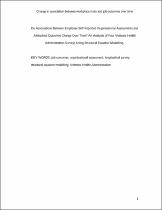 ResearchSpace
ResearchSpace
Do associations between employee self-reported organisational assessments and attitudinal outcomes change over time? An analysis of four Veterans Health Administration surveys using structural equation modelling
JavaScript is disabled for your browser. Some features of this site may not work without it.
- ResearchSpace
- →
- Research Publications/Outputs
- →
- Journal Articles
- →
- View Item
| dc.contributor.author |
Das, Sonali

|
|
| dc.contributor.author |
Chen, M-H

|
|
| dc.contributor.author |
Warren, N

|
|
| dc.contributor.author |
Hodgson, M

|
|
| dc.date.accessioned | 2011-05-23T13:03:19Z | |
| dc.date.available | 2011-05-23T13:03:19Z | |
| dc.date.issued | 2010-12 | |
| dc.identifier.citation | Das, S et al. Do associations between employee self-reported organisational assessments and attitudinal outcomes change over time? An analysis of four Veterans Health Administration surveys using structural equation modelling. Health Economics, 20: n/a. doi: 10.1002/hec.1692 | en_US |
| dc.identifier.issn | 1099-1050 | |
| dc.identifier.uri | http://onlinelibrary.wiley.com/doi/10.1002/hec.1692/pdf | |
| dc.identifier.uri | http://hdl.handle.net/10204/5009 | |
| dc.description | Copyright: 2010 Wiley. This is the pre print version of the work. The definitive version is published online in Health Economics, http://onlinelibrary.wiley.com/doi/10.1002/hec.1692/pdf | en_US |
| dc.description.abstract | This paper evaluates relationships between healthcare employees’ perceptions of three hospital organisational constructs (Leadership, Support and Resources), and their assessment of two employee-related outcomes (employee satisfaction, retention) and two patient-related outcomes (patient satisfaction, quality of care). Using four all-employee surveys conducted by the Veterans Health Administration in the United States between 1997 and 2006, we examine the strength of these relationships and their changes over time. Exposure and outcome measures are employee-assessed in all the surveys. Because it can accommodate both latent and measured variables into the model, Structural Equation Modelling (SEM) is used to capture and quantify the relationship structure. The aim of the project is to identify possible intervention foci. The analyses revealed that employee-related outcomes are improved by increases in Leadership and Support, and, not surprisingly, the outcome variable of employee satisfaction reduced turnover intention. The employee assessed patient-related outcomes of satisfaction and quality of care were most improved by increases in Resources. Results also indicate that the three organizational constructs and the web of associations characterized by SEM underwent changes over the study period, perhaps in relation to changes in VHA policy emphases, changes in survey wording, and other possible unmeasured factors. | en_US |
| dc.language.iso | en | en_US |
| dc.publisher | Wiley | en_US |
| dc.relation.ispartofseries | Workflow;4885 | |
| dc.subject | Job outcomes | en_US |
| dc.subject | Organisational assessment | en_US |
| dc.subject | Longitudinal survey | en_US |
| dc.subject | Structural equation modelling | en_US |
| dc.subject | Veterans Health Administration | en_US |
| dc.title | Do associations between employee self-reported organisational assessments and attitudinal outcomes change over time? An analysis of four Veterans Health Administration surveys using structural equation modelling | en_US |
| dc.type | Article | en_US |
| dc.identifier.apacitation | Das, S., Chen, M., Warren, N., & Hodgson, M. (2010). Do associations between employee self-reported organisational assessments and attitudinal outcomes change over time? An analysis of four Veterans Health Administration surveys using structural equation modelling. http://hdl.handle.net/10204/5009 | en_ZA |
| dc.identifier.chicagocitation | Das, Sonali, M-H Chen, N Warren, and M Hodgson "Do associations between employee self-reported organisational assessments and attitudinal outcomes change over time? An analysis of four Veterans Health Administration surveys using structural equation modelling." (2010) http://hdl.handle.net/10204/5009 | en_ZA |
| dc.identifier.vancouvercitation | Das S, Chen M, Warren N, Hodgson M. Do associations between employee self-reported organisational assessments and attitudinal outcomes change over time? An analysis of four Veterans Health Administration surveys using structural equation modelling. 2010; http://hdl.handle.net/10204/5009. | en_ZA |
| dc.identifier.ris | TY - Article AU - Das, Sonali AU - Chen, M-H AU - Warren, N AU - Hodgson, M AB - This paper evaluates relationships between healthcare employees’ perceptions of three hospital organisational constructs (Leadership, Support and Resources), and their assessment of two employee-related outcomes (employee satisfaction, retention) and two patient-related outcomes (patient satisfaction, quality of care). Using four all-employee surveys conducted by the Veterans Health Administration in the United States between 1997 and 2006, we examine the strength of these relationships and their changes over time. Exposure and outcome measures are employee-assessed in all the surveys. Because it can accommodate both latent and measured variables into the model, Structural Equation Modelling (SEM) is used to capture and quantify the relationship structure. The aim of the project is to identify possible intervention foci. The analyses revealed that employee-related outcomes are improved by increases in Leadership and Support, and, not surprisingly, the outcome variable of employee satisfaction reduced turnover intention. The employee assessed patient-related outcomes of satisfaction and quality of care were most improved by increases in Resources. Results also indicate that the three organizational constructs and the web of associations characterized by SEM underwent changes over the study period, perhaps in relation to changes in VHA policy emphases, changes in survey wording, and other possible unmeasured factors. DA - 2010-12 DB - ResearchSpace DP - CSIR KW - Job outcomes KW - Organisational assessment KW - Longitudinal survey KW - Structural equation modelling KW - Veterans Health Administration LK - https://researchspace.csir.co.za PY - 2010 SM - 1099-1050 T1 - Do associations between employee self-reported organisational assessments and attitudinal outcomes change over time? An analysis of four Veterans Health Administration surveys using structural equation modelling TI - Do associations between employee self-reported organisational assessments and attitudinal outcomes change over time? An analysis of four Veterans Health Administration surveys using structural equation modelling UR - http://hdl.handle.net/10204/5009 ER - | en_ZA |





